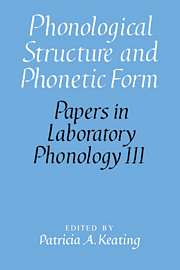Book contents
- Frontmatter
- Contents
- List of contributors
- Acknowledgments
- 1 Introduction
- I Intonation
- II Syllables
- III Feature Theory
- 12 The phonetics and phonology of Semitic pharyngeals
- 13 Possible articulatory bases for the class of guttural consonants
- 14 Phonetic evidence for hierarchies of features
- 15 Do acoustic landmarks constrain the coordination of articulatory events?
- IV Phonetic Output
- Index of subjects
- Index of names
12 - The phonetics and phonology of Semitic pharyngeals
Published online by Cambridge University Press: 26 February 2010
- Frontmatter
- Contents
- List of contributors
- Acknowledgments
- 1 Introduction
- I Intonation
- II Syllables
- III Feature Theory
- 12 The phonetics and phonology of Semitic pharyngeals
- 13 Possible articulatory bases for the class of guttural consonants
- 14 Phonetic evidence for hierarchies of features
- 15 Do acoustic landmarks constrain the coordination of articulatory events?
- IV Phonetic Output
- Index of subjects
- Index of names
Summary
Introduction
An adequate theory of phonological distinctive features must meet four criteria: (i) it must have a relatively consistent and direct relation to the phonetic properties of speech sounds; (ii) it must be able to describe all and only the distinctions made by the sound systems of any of the world's languages; (iii) it must be able to characterize all and only the natural classes of sounds that recur in the phonological phenomena of different languages; and (iv) it must correctly characterize the subgrouping of features by recurrent phonological phenomena. The third criterion is the most important one and probably the hardest to achieve. The fourth has assumed greater importance in the last five years or so in the context of work on feature geometry (Clements 1985; Sagey 1986; and others).
The Semitic languages have many consonants produced with a primary constriction in the posterior regions of the vocal tract. Traditional grammars refer to these consonants as “gutturals.” Standard Arabic and most modern Arabic dialects have retained the full set of gutturals usually reconstructed for Proto-Semitic: laryngeals ʔ and h; pharyngeals ħ and ʕ; and uvulars χ and ʁ. Other Semitic languages, as well as several other branches of the larger Afro-Asiatic family, have similar or smaller inventories of gutturals.
The phonology of the various Semitic languages provides a remarkable range of evidence that the gutturals are treated as a natural class by phonological rules. This can be shown through independent developments in the various languages at different historical periods and in different areas of the phonology.
- Type
- Chapter
- Information
- Phonological Structure and Phonetic Form , pp. 191 - 233Publisher: Cambridge University PressPrint publication year: 1994
- 114
- Cited by



